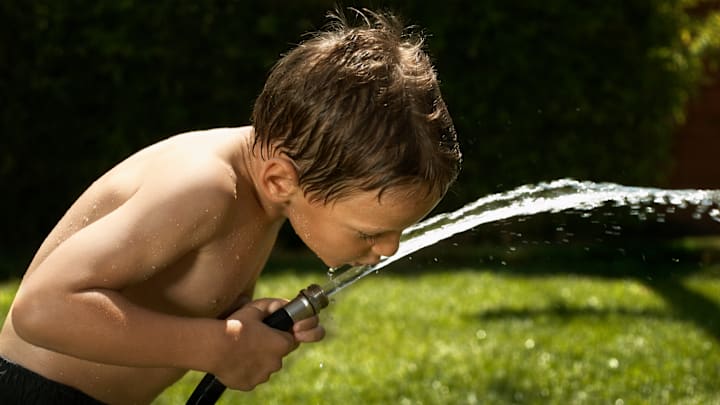It’s a hot summer day. You’re laboring outdoors in the garden, or maybe returning from a walk around the neighborhood. You’re thirsty. A coiled-up garden hose sits in your backyard. You reason it’s basically tap water, so you consider taking a few gulps. Should you? Or is garden hose water somehow dangerous?
The short answer: It’s a terrible idea, and there are plenty of reasons why.
The Dangers of Drinking From a Garden Hose
The problem with ingesting water delivered by a hose isn’t really the water itself, which is typically sourced from your city’s public supply. (Tap water deemed unsafe to drink by local officials is another story entirely.) What makes the water unpotable is the hose delivering it.
Garden hoses aren’t generally considered food-grade, meaning manufacturers use a variety of chemicals and materials that would never be permitted for anything intended for human consumption. Chemicals can include lead, long proven to be neurotoxic—particularly for children—as well as other contaminants. These compounds are meant to keep the hose flexible, which is the manufacturer’s priority.
In 2016, the Ecology Center in Ann Arbor, Michigan, performed a study [PDF] on 32 retail garden hoses. Twenty-four of them were made of PVC, or vinyl, a common material. The Center reported that the PVC hoses had measurable levels of bromine, antimony (both flame retardants), lead, and phthalates. A third of the hoses had anywhere between 100 parts per million (ppm) and a shocking 68,000 ppm of lead. The U.S. Centers for Disease Control has set no safe level for lead in drinking water.

What’s worse, hoses exposed to the sun can heat up, which can cause the chemicals to further leach into the water in higher concentrations. (Heated water can also be an unwelcome surprise when you’re expecting something cooler.)
The problem persists beyond the hose itself. Think of a hose left on or near soil: It’s likely to be exposed to bacteria, insects, or other contamination. Grabbing one end and sipping from it isn’t much different from grabbing an uncapped water bottle, wiping off the dirt from the opening, and drinking from it. Can you do it? Sure. Is it sanitary? Not really.
Some manufacturers offer hoses that they deem safe to drink from. The Ecology Center study found such hoses to be free of lead, but they still contained phthalates, which can disrupt the endocrine system and affect reproductive health. And that doesn’t address the stagnant water in hoses that have been left to sit, which can be a breeding ground for bacteria and fungi.
Is It Safe for a Dog to Drink From a Garden Hose? |
|---|
The same reasons it’s unwise for humans to drink from a hose apply to dogs, as well. Lead, phthalates, and other chemicals can be harmful to dogs. You should never fill a water bowl from a hose. |
Garden Hoses That Are Safer
It’s generally not a great idea to sip from a garden hose, but you still may want to pursue hoses that are safer for watering plants or for kiddie pools. The Ecology Center study found that hoses made from polyurethane (not PVC) and labeled “drinking water safe” were generally free of toxic contaminants. (One asterisk: Hoses also labeled “lead free” were generally more trustworthy than hoses labeled “lead-free couplings,” which only refer to the metal fasteners, not the entire hose.)
Hoses should also be stored in shade to prevent heat from leaching anything in the material, with the end kept up and away from the ground.
It’s also possible to simply unscrew the hose from the spigot, thereby bypassing all the repulsive chemicals and bacteria in the hose, and drinking directly from that. But then you’d need a drinking cup or water bottle, which is likely inside—and where you can just drink from your tap.
Get Answers to More Big Questions:
